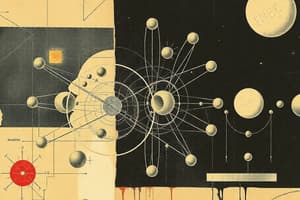Podcast
Questions and Answers
What did John Dalton propose about atoms?
What did John Dalton propose about atoms?
- Atoms can be created or destroyed.
- All atoms of an element have different properties.
- Atoms are made of smaller particles called protons.
- Atoms are identical within each element. (correct)
Which model describes the atom as a 'miniature solar system'?
Which model describes the atom as a 'miniature solar system'?
- Rutherford's model
- Bohr's model (correct)
- Thomson's model
- Mendeleev's model
What does the nucleus of an atom contain?
What does the nucleus of an atom contain?
- Protons and neutrons (correct)
- Protons and electrons
- Electrons and neutrons
- Neutrons and positively charged particles
Which of the following statements is true regarding electrons?
Which of the following statements is true regarding electrons?
What is matter defined as?
What is matter defined as?
What did J.J. Thomson introduce with his 'plum pudding' model?
What did J.J. Thomson introduce with his 'plum pudding' model?
Who is credited with introducing the first periodic table of elements?
Who is credited with introducing the first periodic table of elements?
What charge does a neutron carry?
What charge does a neutron carry?
What happens to an atom during alpha emission?
What happens to an atom during alpha emission?
Which of the following describes beta emission?
Which of the following describes beta emission?
After undergoing alpha decay, Radium-226 becomes which of the following?
After undergoing alpha decay, Radium-226 becomes which of the following?
Why do unstable nuclei emit particles or energy?
Why do unstable nuclei emit particles or energy?
What is the effect of alpha emission on the atomic mass of an atom?
What is the effect of alpha emission on the atomic mass of an atom?
What is the relationship between protons and electrons in a neutral atom?
What is the relationship between protons and electrons in a neutral atom?
How many maximum electrons can exist in the L shell?
How many maximum electrons can exist in the L shell?
What defines an isobar in nuclear chemistry?
What defines an isobar in nuclear chemistry?
What happens during ionization?
What happens during ionization?
Which shell can hold a maximum of 32 electrons?
Which shell can hold a maximum of 32 electrons?
What is the principal quantum number commonly labeled as?
What is the principal quantum number commonly labeled as?
What distinguishes isotopes from one another?
What distinguishes isotopes from one another?
In an ionized atom with 5 protons and 6 electrons, what is the charge of the atom?
In an ionized atom with 5 protons and 6 electrons, what is the charge of the atom?
What does the period number in the periodic table represent?
What does the period number in the periodic table represent?
Which shell has electrons with the highest binding energy?
Which shell has electrons with the highest binding energy?
How does the number of protons in an atom affect electron binding energy?
How does the number of protons in an atom affect electron binding energy?
Which type of radiation can remove tightly bound electrons from an atom?
Which type of radiation can remove tightly bound electrons from an atom?
What effect does a larger atom have on the energy needed for ionization?
What effect does a larger atom have on the energy needed for ionization?
Which of the following is an example of non-ionizing radiation?
Which of the following is an example of non-ionizing radiation?
Which electrons in an atom are less tightly bound to the nucleus compared to K-shell electrons?
Which electrons in an atom are less tightly bound to the nucleus compared to K-shell electrons?
The L shell contains which of the following?
The L shell contains which of the following?
What occurs during alpha decay?
What occurs during alpha decay?
Which type of particle is produced when a neutron decays?
Which type of particle is produced when a neutron decays?
What is a result of nuclear fission?
What is a result of nuclear fission?
Why do atoms undergo radioactive decay?
Why do atoms undergo radioactive decay?
What characterizes a radionuclide?
What characterizes a radionuclide?
What happens when the ratio of neutrons to protons is unstable?
What happens when the ratio of neutrons to protons is unstable?
Which of the following statements about radioisotopes is true?
Which of the following statements about radioisotopes is true?
What distinguishes protons from other particles mentioned?
What distinguishes protons from other particles mentioned?
Flashcards are hidden until you start studying
Study Notes
Atoms: History, Models, & Structure
- Atoms are the fundamental building blocks of matter and the smallest units of matter.
- All matter occupies space and has mass, and is composed of atoms.
- Greek philosophers classified matter into four primary substances: Earth, Water, Air, and Fire.
- Dmitri Mendeleev created the first periodic table of elements, building on John Dalton's earlier work.
- John Dalton proposed that elements consist of identical atoms, differentiated by atomic mass and described atoms using “eyes and hooks”.
- J.J. Thomson introduced the "plum pudding" model, depicting electrons as "plums" in a positively charged "pudding".
- Ernest Rutherford proposed the nuclear model of the atom, highlighting a small, dense positive nucleus surrounded by electrons.
- Niels Bohr likened the atom to a miniature solar system, with electrons orbiting the nucleus in fixed energy levels.
- The atom comprises three fundamental particles:
- Electrons (-): Small, negatively charged particles orbiting the nucleus.
- Protons (+): Positively charged particles located in the nucleus.
- Neutrons: Electrically neutral particles in the nucleus.
Atomic Structure
- In neutral atoms, the number of electrons equals the number of protons.
- Ionization occurs when an atom gains or loses an electron, resulting in a charge.
- Electron arrangement across shells follows a specific pattern, with maximum electrons per shell calculated using 2(n^2):
- K shell: 2 electrons
- L shell: 8 electrons
- M shell: 18 electrons
- N shell: 32 electrons
- O shell: 50 electrons
- P shell: 72 electrons
- Q shell: 98 electrons
- The principal quantum number (n) indicates the shell number and relates to the periodic table's structure.
- Electron binding energy varies, with K-shell electrons having higher binding energy compared to electrons in higher shells.
- Larger atoms (more protons) have electrons that are more tightly bound, requiring more energy for ionization.
Radiation: The Basics
- Radiation is divided into non-ionizing and ionizing types.
- Non-ionizing radiation includes radio waves, microwaves, infrared, and ultraviolet, lacking energy to ionize atoms.
- Ionizing radiation can remove tightly bound electrons, leading to ionization; examples include alpha, beta, neutron, and proton particles.
- Alpha particles are emitted from radioactive decay; beta particles result from neutron conversion into protons and the emission of an electron.
- Nuclear fission splits unstable atoms into smaller, more stable pieces, releasing energy and additional neutrons.
Radioactivity
- Neutral atoms have an equal number of protons and electrons, while radioactive atoms have unstable nuclei.
- Radioactive decay (disintegration) allows unstable nuclei to emit particles/energy to achieve stability.
- Radionuclides are atoms involved in radioactive decay; each atom seeks stability through this process.
- Neutron count influences nuclear stability; imbalances can lead to radioactive disintegration.
- Radioisotopes can occur naturally or be artificially produced in reactors/accelerators.
- Stability can be achieved through alpha emission (loss of 2 protons and 2 neutrons) or beta emission (neutron to proton conversion).
- Alpha emission results in a lighter atom; for example, Radium-226 becomes Radon-222 through this process.
- Beta emission alters atomic number by increasing it, changing the element type in the process.
Studying That Suits You
Use AI to generate personalized quizzes and flashcards to suit your learning preferences.



